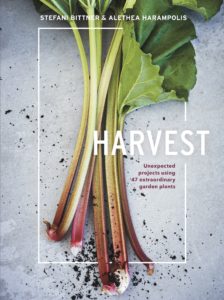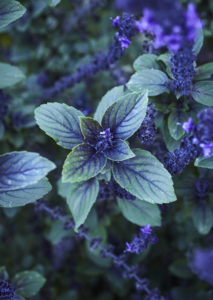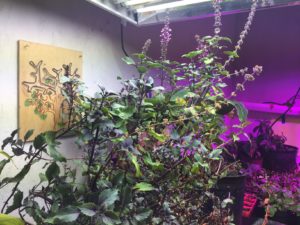Sometimes it takes somebody else’s wisdom to confirm what you already know or partially know. I recently had that experience when I attended the Pacific NW Flower and Garden Show, where I heard author and designer Stefani Bittner of Homestead Design Collective (http://www.homesteaddesigncollective.com/) speaking about her new book, Harvest.
This book confirmed my trials of Wild Magic Basil as a plant most worthy to be grown, and this book is most worthy to be read. It is actually so beautifully conceived and photographed that I have a hard time putting it down…..every time I pick it up!
Her company is fresh off the design of the new Sunset Magazine demonstration gardens in Sonoma, CA, and one of the stunning photos she showed of that garden included an exceptionally ornamental basil. She began to talk about the plant, calling it a “flowering basil” and then, lo and behold, a light went off that I had just trialed the very plant at Noble Rot this past season and was bringing it through the winter in my grow room, ready for further evaluation this coming season. I hadn’t given the basil pride of place in the garden (or my mind, I guess) because I was still watching it, given that it was new to me, but after hearing her mention the plant’s potential, both ornamentally and culinarily, I raced home, admired my plant overwintering in the basement grow room, and patted myself on the head for making a good selection. The basil is called Wild Magic, and here’s why it’s awesome (a mix of Stefani’s and my own observations):
Check out the depth of color… if only you could smell it!
- It’s super fragrant. Just a passing graze of this plant releases clouds of fruity, spicy scent, that I find simultaneously stimulating and relaxing. Right away it gets big points for aromatherapy. It would/will make an intoxicating border plant.
- It’s stunningly beautiful. If the dark purple-veined, dark-hued leaves don’t stop you, then the light purple flower spikes will. Unlike culinary basil, there’s no need to fear the flowers because these basils are bred to continue leaf production even as flowers abound. Flowers and leaves continue through the (long) season in abundant co-proliferation. Bittner follows her description of flowering basils with a photo of an arrangement, and I must say the basil’s curvaceous spikes are not only supremely attractive curling out of the vase, but somehow make the plant seem like it possesses a kind of curiosity for the goings-on at the dinner table.
- It is vigorous. Because this basil is bred sterile (it does not produce viable seed), the plant does not receive the message to shut down production after it flowers; thus, it continuously produces both leaves and flowers throughout the season. It’s Sisyphean from the plant’s perspective, condemned to flower all season long without being able to produce a single seed with which to ensure its passage to the next season, but from the gardener’s perspective it’s a pure boon. It pumps out! The plant is also hardier than culinary basils, and it continued to look good long after my Genovese had browned and died. Indeed its still-vigorous presence on a darkening October day gave me the idea to lift it, pot it, and bring it indoors for the winter. And there it has proven itself hardy in another fashion, withstanding an entire winter in my basement under fluorescent and LED lights, which are generally fine for seedlings but not usually for mature plants. Behaving thus here in Oregon, I would imagine it is perennial outdoors in milder climates.
- It roots easily. Here permit me to discuss a characteristic of this plant without making any recommendations for action. If you cut and display Wild Magic in a vase, you may notice roots developing after a time along the submerged stems. It would not be far-fetched for you to wonder if these cuttings might grow if you planted them in the soil. They would, indeed! Take heed, then, when I tell you that Wild Magic is a patented plant and that patent law does forbid the propagation of such plants by tissue culture (which could be one interpretation of what you are attempting in the vase….provided your intent was to replant, and thus copy, them). Here you must make an ethical judgement on whether to throw those rooted stems out with the vase water or whether to “accidentally” dump them on a weeded portion of your garden and then look puzzled a while later while wondering out loud, “My, how did that beautiful basil get rooted over here in my garden? Well, it’s so pretty I think I’ll just let it stay the season.” For more on plant patent protection see this from the Oregon State’s website: http://extension.oregonstate.edu/gardening/what-does-it-mean-when-nursery-plants-are-patented-or-trademarked.
Here’s my Wild Magic basil in the unnatural winter habitat of my grow room, and still it doesn’t look half-bad. This is a never-say-die plant, and I’m sure it will bounce back with abandon when it soon gets replanted on the rooftop.
Nights are warming, and it’s almost time to bring my Wild Magic out and start accustoming her to the open air again. While I’m waiting for the night time highs to warm a few more degrees, I’m going to keep thumbing through Bittner’s book, finding out more of what I already know and lots of what I don’t!
Thanks to Homestead Design Collective for sharing photos of the book Harvest and of Wild Magic basil.




Hello ! I am trying to grow a baby wild magic basil I saw this beauty at a green house and I was like omg ! Fell in love ! Anyway I loved this article and I’m just going to keep replanting this beauty in bigger pots and see how it goes ! Thank you for this wonderful article!
Thanks, Melissa! Wishing you a lot of success with that.